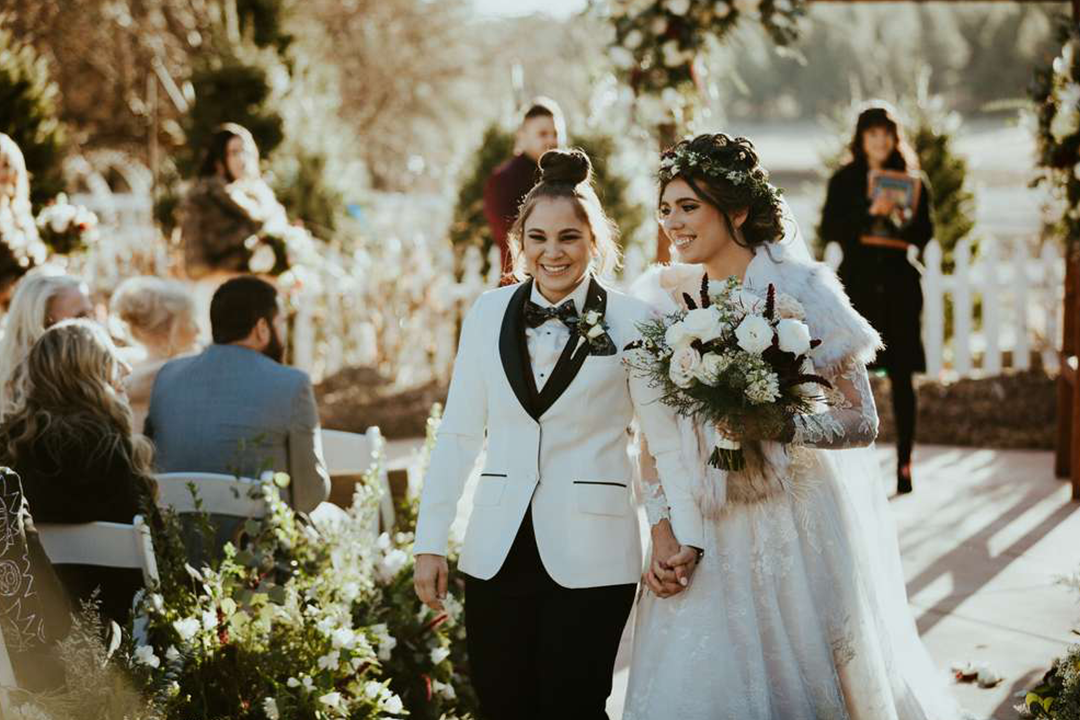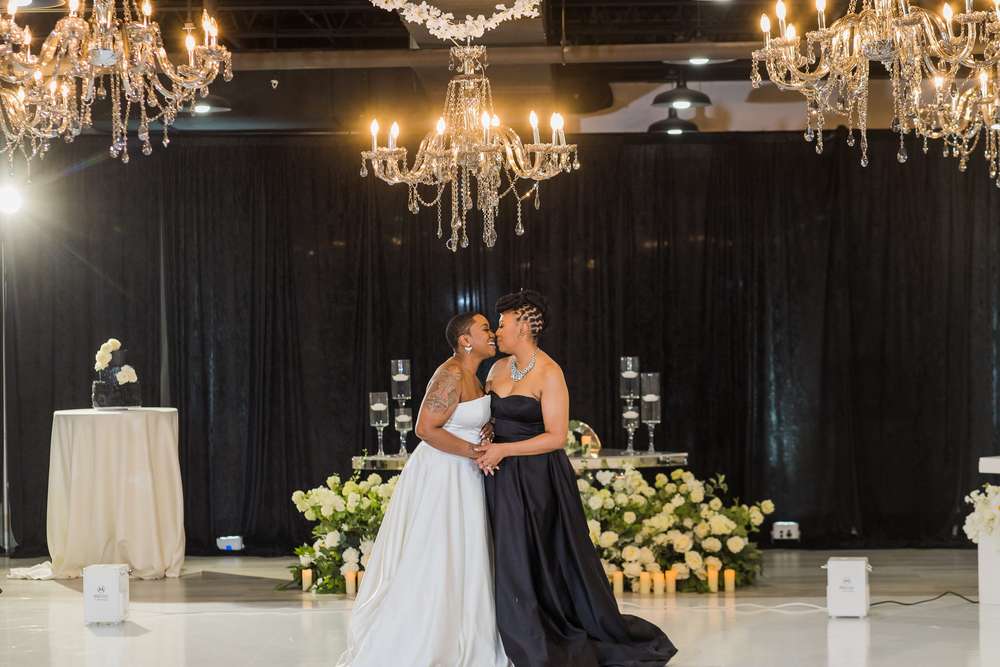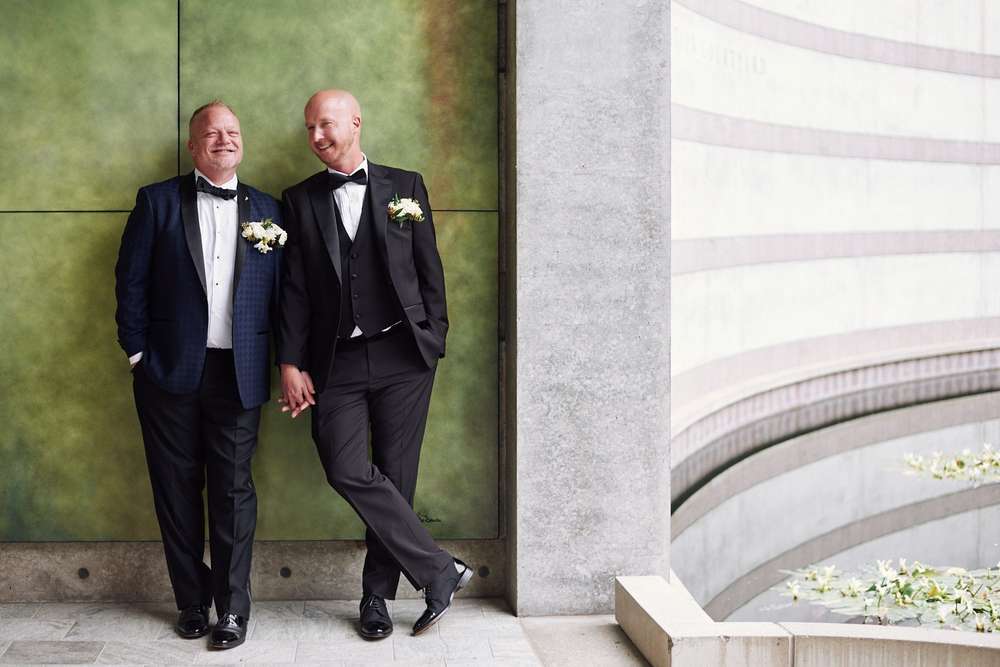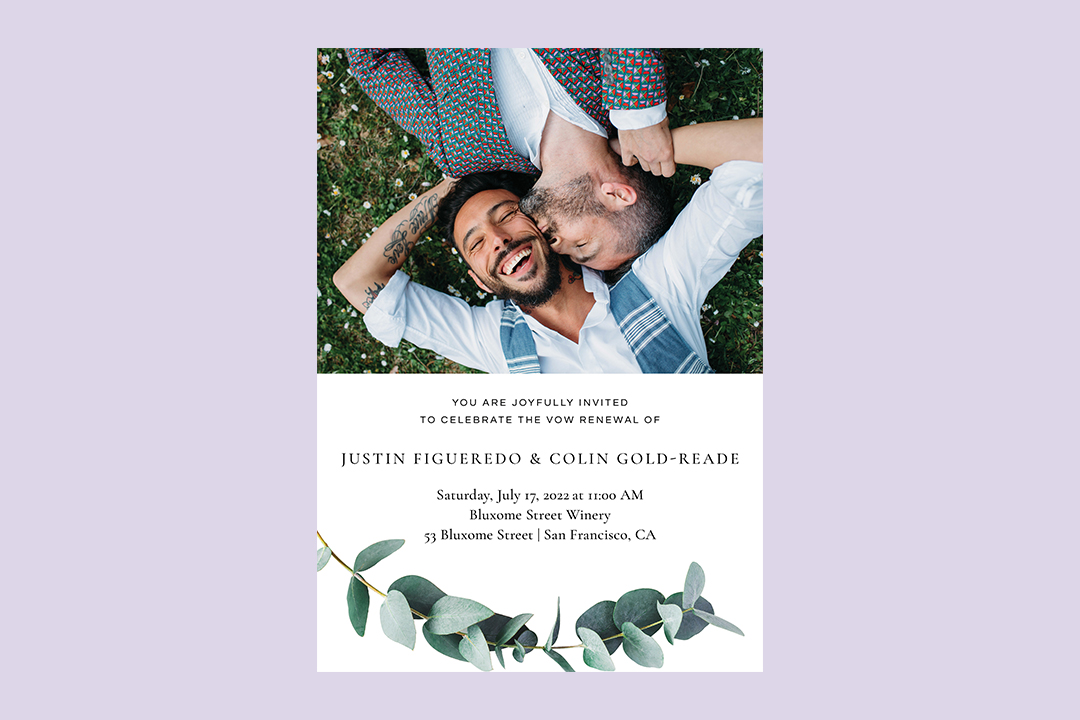- Expert advice/
- Wedding planning 101/
- Wedding planning tools/
- Gender-Neutral Wedding Terms—And Where to Use Them
- Wedding planning tools
Gender-Neutral Wedding Terms—And Where to Use Them
Switching out traditionally gendered terms can actually be a fun and validating part of wedding planning! From save the dates to seating charts, here are all the gender-neutral terms and tips you can use at every stage of the planning process.
Last updated February 5, 2024

Gendered language has long been a part of the wedding world. And while words like bride and groom might feel synonymous with “I dos,” that doesn’t mean gendered wedding terms work for every couple or celebration. The truth is there are a lot of reasons someone might want to nix the binary and instead, opt for gender-neutral language on their big day.
Before you decide whether or not non-gendered language feels good for your day, though, it’s important to unpack what “gender-neutral” really means. According to social worker and LGBTQIA+ educator, Zoe Stoller (she/they), the definition and ideal usage are pretty situational, but when it comes to weddings (and other traditionally gendered events), it’s simply about “removing the typical gender roles and creating a wedding space that’s more inherently inclusive to people of all identities, experiences, and needs.”
To clear up any confusion and inspire couples saying “I do,” we’re outlining everything you need to know about non-binary language and detailing gender-neutral terms you can use throughout your wedding planning journey and the forever that follows.
Why Would Engaged Couples Use Gender-Neutral Language?
One of the main reasons some people — especially those who are non-binary — prefer gender-neutral language is because they feel uncomfortable or unseen when using the gendered terms commonly associated with weddings. “It might not feel affirming to their gender, which is opposite to the goal of your wedding day, which is supposed to make you feel uplifted and affirmed and loved,” Stoller explains.
While not every couple will want to use gender-neutral language — which Stoller stresses is completely fine — it can be affirming for many people, especially those who don't identify as a man or a woman. Beyond that, though, many ally couples whose genders do fall under the binary umbrella prefer to adopt neutral language to help normalize its usage. This is important not only for inclusion, but for creating a safer space in the wedding industry and beyond.
“Currently, if people use gender-neutral terms such as ‘spouse,’ many people make assumptions that the person is queer,” Stoller says. “Queer people might be hesitant to use certain language or reveal certain information out of fear that it will ‘out’ or ‘expose’ them, which they might not want.”
If non-gendered language becomes more commonly used by all couples, it makes the neutral terms safer and more inclusive for non-binary couples to use as well. “This is one of the key roles of allies — being able to normalize language and experiences and help make LGBTQ+ people feel less excluded or ostracized,” notes Stoller.

Gender-Neutral Wedding Terms
While you might not have really thought of it, language is a pretty major part of a wedding. And for days that are supposed to be affirming, feeling misrepresented or misgendered on your special day can feel rightfully devastating. That’s why Stoller says it’s “vital” to select your preferred language if you’re saying “I do,” or adhering to someone’s chosen terms if you’re celebrating a happy couple. If not, it can “cause them dysphoria or make them feel invalidated,” which is the last thing anyone should have to experience, especially on their wedding day.
The good news is, there are tons of gender-neutral wedding terms out there to use at all stages of the wedding planning process. And switching out those traditionally gendered terms is not only easy but can actually be a fun and validating part of the wedding planning process.
Below are a few gender-neutral terms couples or guests can use leading up to the special day and beyond:
- Nearlywed(s): term that can be used to describe the engaged couple or a singular person in the couple before they say “I do.”
- Newlywed(s): You’re technically a newlywed for the first year after marriage, so enjoy using this romantic, non-gendered term to describe your coupleship after saying “I do.”
- Marrier(s): This joyful word means either the person doing the marrying (like the officiant) or one of the people getting married (or both people, if used in the plural form). We love how it encapsulates the excitement of the milestone without being gendered!
- Partner(s): A safe, grounding term for any couple, married or not.
- Significant Other(s): Another all-inclusive term that can be used to describe a person or a couple, whether married, engaged, or dating.
- Spouse(s): Instead of “husband” or “wife,” this term implies that the person (or people, if you’re using it to describe a couple) is married.
- Future Spouse: This term describes one half of an engaged couple.
- To-Be-Wed(s): Similar to nearlyweds, this gender-neutral term describes an engaged couple before their wedding.
- Couple: A way to describe two people in a relationship regardless of whether or not they’re married, engaged, or dating.
- Fiance: While this term can be gendered ("fiancee" refers to a betrothed woman), the general spelling can be a gender-neutral term when written or spoken. It’s similar to saying “partner” but in this case, the partner is someone you’re engaged to.
- Broom/Gride: Modern combinations of “bride” and “groom” that have been recently gaining traction. These terms can be used to describe a member of the engaged couple who is gender-fluid or non-binary.
- Other-Half/Better-Half: The sweet, non-gendered term can be used to describe your partner whether you’re dating, engaged, newlyweds, or have been together for years.
- Soulmate(s): Another tender way to describe your partner (or your coupleship, when used in the plural) no matter your marital status.
- Bachelorx: The non-gender version of “bachelor” or “bachelorette.” Use the term to describe the person or the party!
- Best Person/Person of Honor: There’s no need to have the titles of “best man” or “maid of honor” if that doesn’t adhere to your or your attendants’ gender identities. Best Person or Person of Honor is another way to describe the head person on either side of the wedding party.
- Mate of Honor: Another way to acknowledge the head member of either side of the wedding party, a “Mate of Honor” is used to acknowledge your friendship without gendering the individual.
- Bridesmates/Groomsmates: If the to-be-wed couple is binary but they have non-binary members or multiple genders on either side of their wedding party, “bridesmates” instead of “bridesmaids” and “groomsmates” instead of “groomsmen is a nice change from the traditionally less inclusive terms.
- Ring Bearer: The attendant — traditionally a child — who carries the rings down the aisle. This traditional term is non-gendered, so it can apply to anyone!
- Wedding Party: Bridal party, bridesmaids, and groomsmen are all gendered, so instead, use the term “wedding party” to describe the people who stand by your side on the special day.
- Attendants: A non-gender specific way to describe members of the wedding party.
- Flower Person/Pal/Child: A non-gendered take on the traditional “flower girl” title. The role is typically a child who either carries or tosses flowers down the aisle during the processional.
- Mx.: If you want to use honorifics—formal titles such as Mr. and Mrs—for place cards or your own paper goods, “Mx” is a popular, gender-neutral, formal title.
- [Your Names]: If none of the terms feel right, or if you’re a guest and unsure, simply using the couples’ names is always an acceptable option!
How to Use Gender-Neutral Terms when Wedding Planning
Not only are there many gender-neutral wedding terms to choose from, but there are also plenty of opportunities to use your chosen terms as well! “This can be as simple as the labels that are used in reference to the couple getting married (which appear in various settings), to how the marrying couple is introduced to the public day-of,” Stoller explains.
If you’re a guest trying to determine how to address the new couple, check their wedding website for clues or direction. If it’s unclear, respectfully ask! The nearlyweds will appreciate you taking the time to honor their identities and use their preferred language/terms.
Save the Dates
Gendered language isn’t typically used on save-the-dates. Instead, the format usually includes the to-be-weds’ names, city of the wedding, date, and website information. If you’re looking to switch up the typically save-the-date format (which we support!) some of the best non-gendered terms to use are:
- Nearlyweds
- To-be-weds
- Marriers
- Soulmates
- Fiances
Just make sure to still include your names so guests know who’s getting married!
Invitations
Traditional wedding invitations don’t typically include gendered language either, and instead, list the names of the couple, the name(s) of the host(s), the location, the time of the event, and the wedding website URL. Wedding shower invitations, however, are a place where gendered language can be heavy. Instead of the typically binary like “bride” or “groom,” here are a few of our favorite non-gendered invite/party terms:
- Nearlywed
- Marrier
- To-be-wed
- Gride/Broom
- Future Spouse
- Bachelorx
Wedding Website
Consider your wedding website the place to make your language choices crystal clear. For some couples, this means simply using honorifics like “Mx.” or gride and broom instead of bride and groom.
For other couples, it means making a special note on the website or having a Q&A section to clear up any confusion. It might seem in-your-face, but your guests will appreciate the transparency—they’re there to celebrate you exactly as you desire, after all, so make your preferred pronouns and/or language clear. Pick and choose whichever terms feel right for your day, your bond, and your event. Some of the most common include:
- To-be-weds
- Nearlyweds
- Soon-to-be-newlyweds or Almost Newlyweds
- Marriers
- Gride and Broom
- Future Spouse(s)
- [Your names]
- Future Mx. and Mx. [insert future last name if you’re going to share a family name]
Seating Charts/Placecards
When working on your seating chart, there’s no need to use pronouns if you’re just trying to figure out where people should go for personal use. Just their names work best here. But when it comes time to make your wedding place cards or you’re putting your seating chart (or chart information) on a sign to help direct guests, honorifics—which are often gendered—are traditional. That doesn’t mean titles are required, though. Simply using guests’ full names (or first initial with last name) is a fantastic option.
If you love the idea of honorifics, make sure everyone gets one—don’t just skip over someone because you don’t know how they identify. Be sure to connect with guests regarding their preferred pronouns first since you should never misgender someone. An easy way to do this is to request guests' pronouns with their RSVPs, just like you would food preferences and song requests.
Here are some good seating chart/place card options:
- For all guests: [Full Name]
- For all guests: First Initial + Last Name]
- For all guests: Honorifics such as Mr., Mrs., Ms., Mx. (a gender-neutral honorific), and Dr.
Day of Paper
Pamphlets, napkins, and notes for your VIPs are a few ways you might want to use a wedding-related gender-neutral term at your wedding. And if you’re a guest, using a sweet, gender-neutral wedding term on your card — whether physical or virtual — is a nice touch to commemorate the special day. Below are a few non-gendered terms we love for paper goods:
- Newlyweds
- Gride and Broom
- Soulmate(s)
- Spouse(s)
- The Happy Couple
- Mx. and Mx. [insert last name if it’ll be shared]
Signage
From venue directions to signs with your wedding hashtag or signature drinks, there are plenty of opportunities to use some special, gender-neutral wedding terms. While the options are limitless, these are some of the most popular:
- The Newlyweds/Nearlyweds
- Soulmate(s)
- Mx. and Mx. [insert last name if it’ll be shared]
- The Happy Couple
Additionally, if you’re comfortable, it’s also a good idea to work with your venue to replace gendered signage for restrooms, making them unisex.

Tips for Communicating the Use of Gender-Neutral Language
Unfortunately, since gender-neutral language hasn’t been used in the mainstream wedding industry for as long as binary language, some of your guests and vendors might not be as accustomed to the tweaks. That’s why Stoller says it’s a good idea to open up the lines of communication to outline your preferred terms and explain the importance of using them leading up to and the big day.
Here’s how to ensure everyone’s on the same page, language-wise, before your wedding:
To Your Guests
One major perk about wedding planning is that there are ample opportunities to inform your guests of your language preferences. First, you can make your gender-neutral term choices clear via invitations and written stationery, Stoller explains. “Including someone’s pronouns, like Mx., or including the specific gender-neutral labels you’re using in your wedding — like “nearlyweds” instead of “bride and groom” — is a fantastic first step. You can even make some signs for your venue that say “here come the broom/gride” or “Mx. and Mx. (last name)” to make your preferences even clearer. When these terms are reinforced via vendors and signage, most guests will catch on.
That said, it can also be a good idea to make your chosen language explicitly stated on your wedding website. This can be done with a simple sentence or paragraph, or if you really want to inform, you could have a whole section about gender-neutral language usage. While it’s not your job to educate, some guests might enjoy the opportunity to learn more. Either way, starting your preferred language clearly takes any guesswork out for guests so they can comfortably use celebratory terms that you feel good about.
If there are any guests you’re worried either won’t understand or won’t respect your preferred language, consider reaching out to them individually. You can do this personally if you're comfortable, but if not, enlist a wedding party member or more receptive relative to have that conversation. Ultimately, you’re never under any obligation to do anything that makes you feel unsafe, and you're allowed to disinvite or cut off anyone who doesn’t support your pronouns and/or chosen language.
To Your Vendors
When it comes to your vendors, Stoller advises sharing your preferred language with them ASAP. This helps ensure they use the correct language when referring to you from the get-go at all stages and in all aspects of the wedding planning process. “You can do this by directly emailing or sharing your preferred language in conversation, but I recommend being direct with your needs in order to make sure they are met,” they explain.
You can also search for LGBTQIA+ vendors when you’re in the initial planning stages to ensure your wedding team is well versed in all things neutral language and proud weddings. Zola is a great resource for non-binary couples looking for LGBTQIA+ and ally vendors. That’s because every vendor in Zola’s marketplace is required to agree to a “Vendor Pledge.” This states that the vendor “respects every couple’s right to marry” and will treat every couple equally “regardless of their sexual orientation, gender identity, race, ethnicity, religion, or budget.”
Ultimately, choosing to use gender-neutral terms for your wedding celebration is a very personal decision, and it doesn’t work for everyone. But that’s what’s so great about evolving terms — it means there are options that’ll ensure you feel seen at all life stages. “Everyone gets to use whatever language feels most affirming to them on their special day and beyond,” Stoller says. So whether that means the bride or the broom is walking down the aisle, embrace your chosen terms to help usher in the next authentic, validating, and comfort-filled season of your love story.
Up next for you
- Expert advice/
- Wedding planning 101/
- Wedding planning tools/
- Gender-Neutral Wedding Terms—And Where to Use Them
Find even more wedding ideas, inspo, tips, and tricks
We’ve got wedding planning advice on everything from save the dates to wedding cakes.


